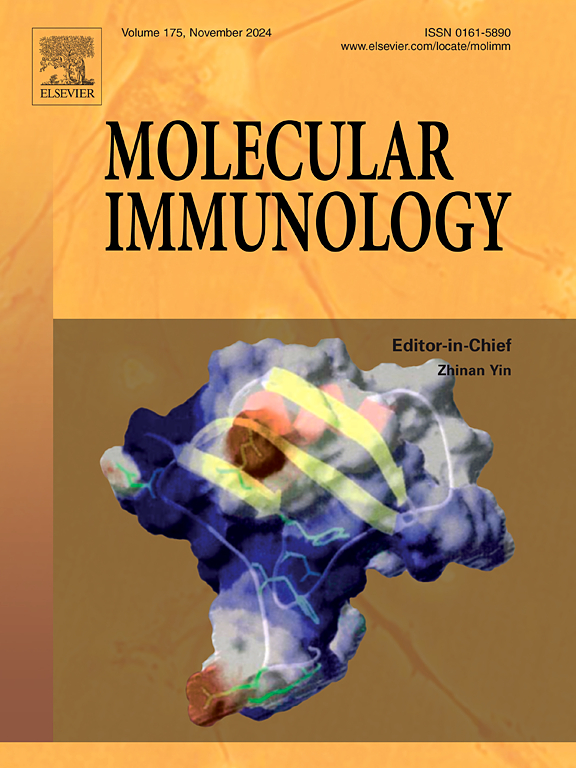厄瓜多尔移植候选者HLA I类和II类等位基因多样性:一项全面的回顾性分析
IF 3
3区 医学
Q2 BIOCHEMISTRY & MOLECULAR BIOLOGY
引用次数: 0
摘要
主要组织相容性复合体(MHC)包含超过220个编码蛋白质的基因,这些蛋白质对免疫系统的功能至关重要。这些基因分为三类:HLA I类、II类和III类。MHC基因的多态性通过增加抗原呈递的多样性来增强免疫应答。厄瓜多尔是一个由众多民族组成的多样化人口的国家,了解HLA等位基因的分布对于促进个性化医疗和器官移植等几种保健方法至关重要。本研究采用了厄瓜多尔国家器官、组织和细胞捐赠与移植研究所(INDOT) 2017年至2022年的数据。分析数据,确定HLA I类(HLA- a、HLA- b、HLA- c)和II类(HLA- drb1、DRB3、DRB4、DQB1)等位基因的分布。在纳入研究的2352例患者中,共鉴定出1530个HLA等位基因。变异最大的是I类等位基因,其中HLA-A02(32 %)和HLA-B35(21 %)最为常见。在II类中,最常见的等位基因是DRB104和DQB103,频率分别为25.1 %和48 %。值得注意的是,在厄瓜多尔各地观察到等位基因频率的显著区域差异。这项综合研究的发现为了解厄瓜多尔的HLA等位基因分布提供了有价值的见解,有助于基因研究、个性化医疗和器官移植匹配。然而,这些结果也强调了进一步研究以更好地了解遗传多样性和改善公共卫生策略的必要性。本文章由计算机程序翻译,如有差异,请以英文原文为准。
HLA Class I and II allelic diversity among Ecuadorian transplant candidates: A comprehensive retrospective analysis
The Major Histocompatibility Complex (MHC) comprises over 220 genes encoding proteins that are vital for the functioning of the immune system. These genes are divided into three classes: HLA class I, II, and III. The polymorphism of MHC genes serves to enhance the immune response by increasing the diversity of antigen presentation. In Ecuador, a country with a diverse population comprising numerous ethnic groups, it is crucial to comprehend the distribution of HLA alleles in order to facilitate several health approaches such as personalized medicine and organ transplantation. The present study employed data from Ecuador's National Institute of Organ, Tissue, and Cell Donation and Transplantation (INDOT) from 2017 to 2022. The data were analyzed to determine the distribution of HLA class I (HLA-A, HLA-B, HLA-C) and class II (HLA-DRB1, DRB3, DRB4, DQB1) alleles. A total of 1530 HLA alleles were identified among the 2352 patients included in the study. The highest variability was observed in Class I alleles, with HLA-A02 (32 %) and HLA-B35 (21 %) being the most common. In the case of class II, the most prevalent alleles were DRB104 and DQB103, with frequencies of 25.1 % and 48 %, respectively. It is notable that significant regional variations in allele frequencies were observed across Ecuador. The findings of this comprehensive study provide valuable insights into Ecuador's HLA allele distribution, contributing to genetic research, personalized medicine, and organ transplant matching. However, the results also highlight the need for further studies to better understand genetic diversity and improve public health strategies.
求助全文
通过发布文献求助,成功后即可免费获取论文全文。
去求助
来源期刊

Molecular immunology
医学-免疫学
CiteScore
6.90
自引率
2.80%
发文量
324
审稿时长
50 days
期刊介绍:
Molecular Immunology publishes original articles, reviews and commentaries on all areas of immunology, with a particular focus on description of cellular, biochemical or genetic mechanisms underlying immunological phenomena. Studies on all model organisms, from invertebrates to humans, are suitable. Examples include, but are not restricted to:
Infection, autoimmunity, transplantation, immunodeficiencies, inflammation and tumor immunology
Mechanisms of induction, regulation and termination of innate and adaptive immunity
Intercellular communication, cooperation and regulation
Intracellular mechanisms of immunity (endocytosis, protein trafficking, pathogen recognition, antigen presentation, etc)
Mechanisms of action of the cells and molecules of the immune system
Structural analysis
Development of the immune system
Comparative immunology and evolution of the immune system
"Omics" studies and bioinformatics
Vaccines, biotechnology and therapeutic manipulation of the immune system (therapeutic antibodies, cytokines, cellular therapies, etc)
Technical developments.
 求助内容:
求助内容: 应助结果提醒方式:
应助结果提醒方式:


